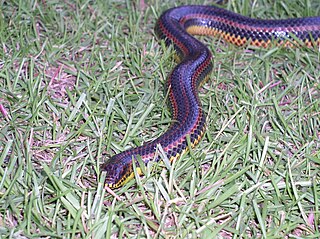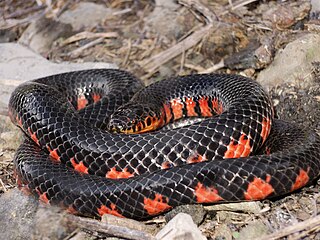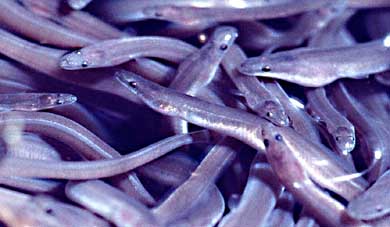Once seen, the beautiful and aptly named Rainbow Snake (Farancia erytrogramma erytrogramma) is not easily forgotten. Yet it remains relatively unknown in the pet trade, principally because of its odd dietary requirements. However, some enterprising snake enthusiasts have found ways to surmount these difficulties, and there have even been a few breeding successes. In my opinion, these unique US natives deserve much more attention, and have great potential as fascinating additions to the collections of experienced snake keepers.
Description
Rainbow Snakes average 3 to 4 feet in length, with a record of 5 feet, 6 inches. Even after a lifetime of snake-keeping, the first I saw stopped me in my tracks. Vivid red and yellow stripes line the blue-black body, while the underside is orange to red in color. Smooth, glossy scales add to the brilliance of these colors. The tail’s terminal scale is hard and somewhat sharp, leading some to mistakenly believe that the Rainbow Snake can “sting” its enemies.
Its closest relative appears to be the Mud Snake, F. abacura (please see photo). Similar in appearance and habits, the Mud Snake is also largely ignored by hobbyists and zoos.
Range
Known in some locales as the Eel Moccasin, the Rainbow Snake may be found from southern Maryland to eastern Louisiana and central Florida.
A subspecies, the Seminole or South Florida Rainbow Snake (Farancia e. seminola), is limited in range to Lake Okeechobee in Florida. It is known from only 3 specimens, and has not been seen since 1952. Some fear that the Seminole Rainbow Snake is extinct, but I hold out hope that its secretive habits (and lack of interest!) are responsible for the lack of recent sightings.
Habitat
These largely-aquatic snakes favor cypress swamps, marshes, oxbow lakes and other sluggish bodies of water, but sometimes forage in nearby fields. Much of its time is spent among floating vegetation or, when on land, within shallow burrows.
Terrarium
An average-sized adult Rainbow Snake can be kept in a 55 – 75 gallon aquarium. They are not comfortable unless able to burrow, so cypress mulch, eucalyptus bark and similar materials should be used as substrates. Despite their aquatic tendencies, Rainbow Snakes may develop fungal skin disorders if unable to dry off; we see this in North America’s watersnakes (Nerodia spp.) as well. The substrate may be kept slightly moist, but dry surfaces (i.e. bark slabs) must be available.
A large water bowl, filled to a point where it will not overflow when the snake enters, will suit their needs. If the snake seems ill-at-ease, floating plastic plants should be placed in the water so that it can shelter below.
An ambient temperature of 75-80 F and a basking temperature of 85-88 F should be established.
Diet
Wild Rainbow Snakes seem to feed almost exclusively upon American Eels. Other fishes, and aquatic salamanders such as amphiumas and sirens, may also be taken (as is the case for the related Mud Snake), but field research is lacking.
Most adult captives refuse all food except American eels. However, scenting minnows, shiners and other fishes with eels has resulted in acceptance. Another option is to search for small eels at bait stores; adult eels can be purchased at food markets and frozen until needed for scenting or use as a meal.
Young Rainbow Snakes are easier to please than adults, and generally accept minnows, shiners, and a variety of other small freshwater fishes. Tadpoles are said to be the preferred food of smaller individuals in the wild; frogs and salamanders are also consumed.
General Care
In common with other fish-eaters, Rainbow Snakes produce copious, watery waste products and require more upkeep than similarly-sized rodent-eating snakes. As nearly all individuals encountered in the trade are wild-caught, new arrivals should be seen by a veterinarian.
Breeding
Captive breeding is rare, although this seems due more to a lack of interest than any inherent difficulties. A slight drop in temperature (68 F by night, 72-80 F by day) may stimulate breeding. Pairs must be monitored carefully, as biting may occur during courtship.
Rainbow Snakes produce unusually large clutches, which range in size from 20 to over 50 eggs. As the eggs are deposited below cover or within shallow burrows, a large nesting box should be provided to gravid females. Hatchlings measure 8 ½ – 11 inches in length.
Temperament
Rainbow Snakes are rather inoffensive, although like all snakes they may bite and should be handled with care. Their first line of defense is usually to thrash about while pressing the hard, terminal scale of the tail against one’s flesh. This can do no harm, but folks who are unprepared may drop the snake in response. This defense mechanism has resulted in their being dubbed “stinging snakes” in some regions.
Further Reading
 That Reptile Blog – Reptile, Amphibian and Exotic Pet Care and Information
That Reptile Blog – Reptile, Amphibian and Exotic Pet Care and Information







Hi Frank,
Kurt Kunze here. It’s been a long time since we last communicated. How have you been?
The reason for this posting is, I have had some experience in keeping a mud snake, Farancia abacura, that I thought I would share. Some time ago, I came across this brightly colored snake at this now defunct reptile shop in Providence. It was black with thin red bands, it had red eyes, and a black and red checkerboard belly. It was gorgeous and cheap, so I got it, but it proved to be difficult to feed. It would only take redbacks, Plethodon cinereus and the occasional small green treefrog, Hyla cinerea that i could find at a local pet store. I had moderate success until midwinter and ran out of salamanders. It didn’t last long after that. Many years later I found out that they are illegal to possess in Massachusetts due to their difficulty in husbandry.
With this and other snakes like it, I learned a valuable lesson. If it is colorful, pretty, and cheap, chances are it eats something difficult to provide regularly. In this case amphibians.
Hi Kurt,
All good here thanks. I hope you are well. Thanks very much…interesting that they can take red-backs..haven’t seen much on their immunities to various toxins. I can’t recall laws banning species due to difficulty in keeping, very good to know. Yes, if it seems too good to be true….! Best, Frank